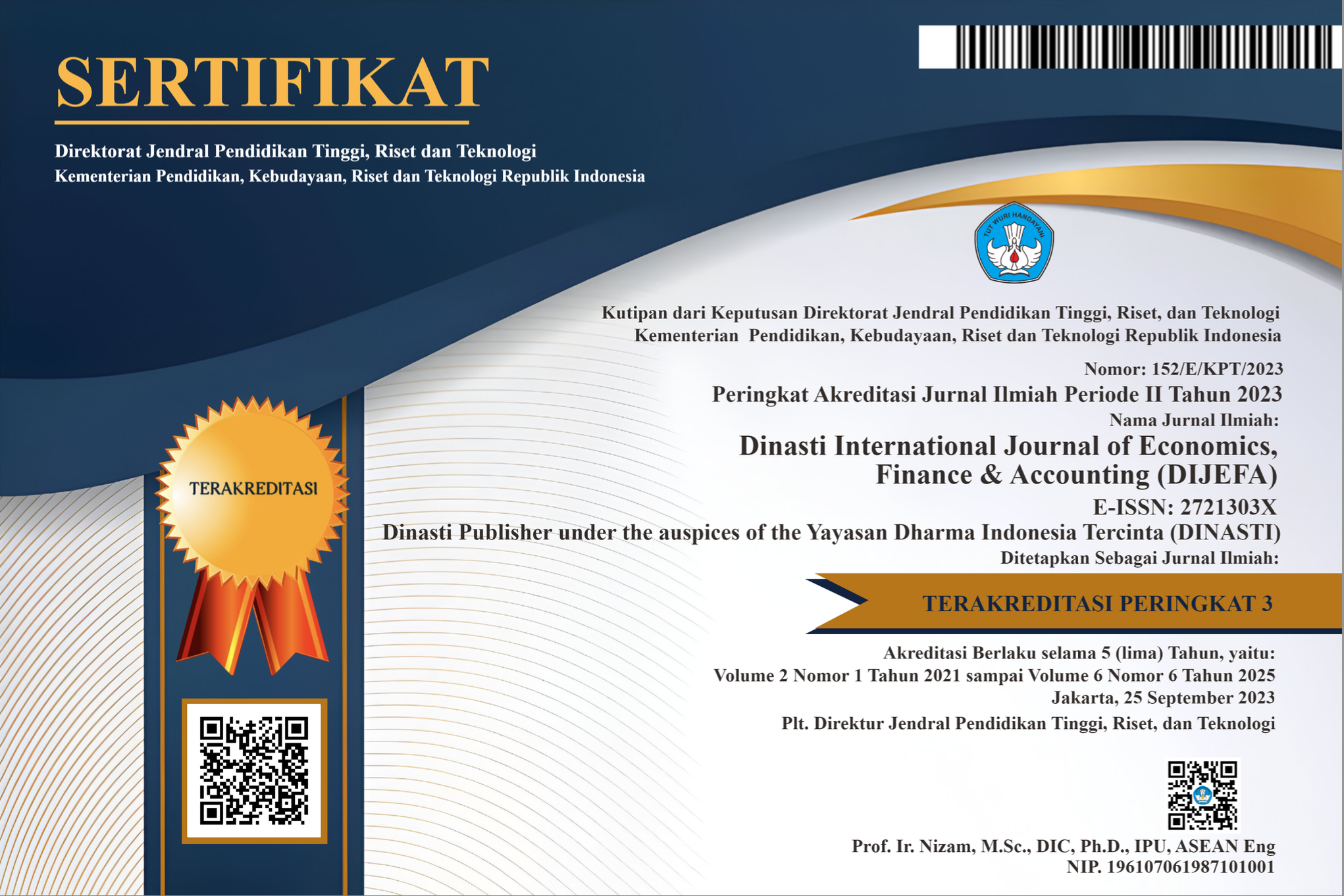Increasing Costs For Development of Air Force Plane on The Financial Stability of Bank Indonesia (BI) In The Defense Budget
DOI:
https://doi.org/10.38035/dijefa.v4i6.2340Keywords:
Aircraft, Indonesian Air Force, Budget, DefenseAbstract
The Indonesian Air Force is directed to increase the fleet of fighter aircraft and radar units to meet Indonesia's air defense needs. Fulfilling air defense needs, especially the construction of Indonesian Air Force aircraft, requires a budget allocation from the government. Policies regarding budget allocations and their implementation certainly require more complex policies. Therefore, it is necessary to map and identify the Increased Cost of Aircraft Development for the Indonesian Air Force on the Financial Stability of Bank Indonesia (BI) in the Defense Budget. This type of research is qualitative with the method of observation, interviews and document studies. Data analysis was carried out interactively descriptive until saturated using the trangulation method. The results of the study indicate that the source of the TNI AU's defense budget comes from the APBN which is sourced from GDP, grants and foreign loans. The dynamics of increasing the defense budget in the procurement of TNI-AU aircraft depend on the dynamics of threats, availability of resources and government policies. The projected increase in the Indonesian Air Force's defense budget tends to fluctuate with an average budget change in 2018-2021 of 42%. The procurement of Indonesian Air Force aircraft is also projected to increase as a way to maintain the sovereignty of the Republic of Indonesia in accordance with the dynamics of the strategic environment. The defense budget affects and is influenced by the financial stability of Bank Indonesia, particularly the APBN, GDP and economic growth.
References
Anggito, A., & Setiawan, J. (2018). Metodologi penelitian kualitatif. Sukabumi: Jejak Publisher.
Dzikri, I. (2016). Negara dan Kapasitas Adopsi Inovasi: Studi Kasus Tranformasi Pertahanan Indonesia Periode 1998-2014. Global: Jurnal Politik Internasional, 18(2), 131. https://doi.org/10.7454/global.v18i2.305
Hadi, A., Sumari, A. D. W., & Djapri, S. (2018). Bauran Kebijakan Fiskal-Moneter Dan Dampaknya Bagi Anggaran Pertahanan. Jurnal Pertahanan & Bela Negara, 6(3), 145–170. https://doi.org/10.33172/jpbh.v6i3.318
Leonard C. Sebastian dan Iisgindarsah, 2013. Taking Stock of Military Reform in Indonesia, Chapter 2. Hal. 15
Montratama, I. (2014). Strategi Optimalisasi Pengadaan Sarana Pertahanan Bagi Industri Pertahanan Indonesia. Jurnal Pertahanan, 4(3), 79–98.
Saputro, G. E., Rivai, A. M., & Meirinaldi. (2021). Pengaruh Anggaran Pertahanan, Impor Alutsista, Ekspor Alutsista, Dan Inflasi Terhadap Pertumbuhan Ekonomi Di Indonesia Tahun 1980-2019. Jurnal Ekonomi, 23(2), 103. https://ejournal.borobudur.ac.id/index.php/1/article/view/801
Savitri, R. N. R., & Prabandari, A. P. (2020). TNI Angkatan Udara dan Keamanan Wilayah Udara Indonesia. Jurnal Pembangunan Hukum Indonesia, 2(2), 236–245. https://doi.org/10.14710/jphi.v2i2.236-245
Downloads
Published
How to Cite
Issue
Section
License
Copyright (c) 2024 Khaerudin, Anton Iman Santosa, Bambang Kustiawan, Arifa F.Z. Muna

This work is licensed under a Creative Commons Attribution 4.0 International License.
Authors who publish their manuscripts in this journal agree to the following conditions:
- The copyright on each article belongs to the author(s).
- The author acknowledges that the Dinasti International Journal of Economics, Finance & Accounting (DIJEFA) has the right to be the first to publish with a Creative Commons Attribution 4.0 International license (Attribution 4.0 International (CC BY 4.0).
- Authors can submit articles separately, arrange for the non-exclusive distribution of manuscripts that have been published in this journal into other versions (e.g., sent to the author's institutional repository, publication into books, etc.), by acknowledging that the manuscript has been published for the first time in the Dinasti International Journal of Economics, Finance & Accounting (DIJEFA).


























































